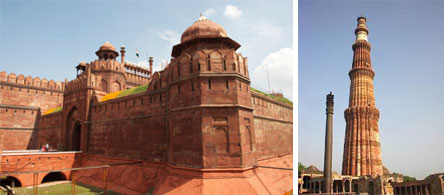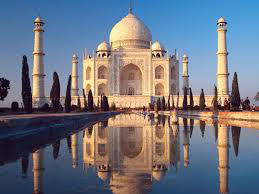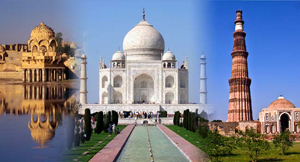Destinations Covered : Delhi-Agra-Jaipur
Delhi, Agra and Jaipur – they represent and unravel the mystique that is India. New Delhi, the elegant capital with its wide roads, sprawling gardens and stately buildings, stands on the site of seven historical cities built by the visionary rulers through the centuries. Agra, the capital of the glorious Mughal emperors, harbors the incomparable Taj Mahal, the exquisite marble monuments that attract millions of visitors every year. Jaipur is the enigmatic pink city of the Maharajas, the city of pomp and splendor, of colour and festivity, of a rich and regal past that continues into the present.
This is the golden triangle – a visit to which is essential to get a glimpse of India’s rich past. Though the cities are a very different in character from each other, their histories have been interconnected, bringing about a similarity in culture, tradition and lifestyle.
Under the grand Mughals, the three cities were linked through political alliances and cultural interchange. Hindu and Muslim traditions influenced architecture, arts and crafts and the result was a unique synthesis, which was reflected, in the literary life and performing arts of the cities.
With the establishment of British India, these three centers were absorbed within the fold of the empire and their colorful histories took a new turn into the future. Located at a motorable distance from each other, these cities are easily accessible and are a must see for every tourist.
Day 01: ARRIVE DELHI
Late evening: On arrival in Delhi by your international flight, meet and greet at the airport and transfer to hotel for immediate occupancy.
Overnight at Delhi
Day 02: IN DELHI
After a relaxed breakfast, proceed for a full day guided city tour of New Delhi and Old Delhi
Delhi – the capital of India, is a fascinating city with complexities and contradictions, beauty and dynamism, where the past co-exists with the present. Many dynasties ruled from here and the city is rich in the architecture of its monuments. Delhi is not only the present metropolis of India but also a Necropolis. Because of its location, being on the banks of the river Yamuna, many cities have risen and fallen over the last five millenniums.
Morning: Sightseeing tour of New Delhi. Visit the Qutab Minar, a Tower of Victory which was built in the 12th century by Qutbuddin Aibak. Within its spacious courtyard stands the Iron Pillar, which dates back to the 4th century AD and bears a Sanskrit inscription in the Gupta style. The pillar has puzzled scientists, as its iron has not rusted in all these centuries. The tomb of Humayun – the magnificent structure in red sandstone and white marble is one of the finest examples of the garden tomb, and a precursor to the Taj Mahal. Its proportionate spaces, double dome and refined elegance are characteristic of Mughal architecture. Also visit India Gate, the memorial of the First World War and the road that leads from there to Rashtrapathi Bhawan – the residence of the President of India which is flanked by the houses of Parliament and the Government Secretariat buildings.

Afternoon: Sightseeing tour of Old Delhi. Visit the historic Red Fort – Shah Jehan’s elegant citadel in red sandstone, which was built as an octagon measuring 900m by 550m and surrounded by a 9 meter deep moat which was at its inception fed by the waters of the Yamuna River. The fort is entered from the Lahori Gate and leads to a roofed passage called Chatta Chowk. The Naqqar Khana (drum house) at the end of this passage marks the entrance to the royal enclosure. A spacious lawn leads to the Diwan-i-Am – the pillared Hall of Public Audience, Diwan-i-Khas – the Hall of Private Audience where the emperor met select visitors and the Pearl Mosque built by Shah Jahan’s son, Aurangazeb, the last of the “Great Mughals”. Very near the Fort is the Jama Masjid (Friday Mosque), India’s largest mosque, also built by Shah Jahan. Take an interesting rickshaw ride through the famous bazaars of Chandni Chowk which is adjacent to both the Fort and the Mosque. Also visit Raj Ghat – the memorial to Mahatma Gandhi.
Overnight in Delhi
Day 03: DELHI / AGRA
After a relaxed breakfast drive to Agra (204 kms/04½ hrs) and on arrival check in at hotel. Afternoon: Guided tour of Taj Mahal and Agra Fort.
Agra is famous as the home to one of the Seven Wonders of the World – the Taj Mahal (closed on Friday). The architectural splendor of the mausoleums, the fort and the palaces in Agra is a vivid reminder of the opulence of the legendary Mughal Empire. Agra was their capital for nearly a hundred years from 1564. A pleasant town, with a comparatively easy pace, Agra is known for its superb inlay work on marble and soapstone by artisans who are hereditary craft persons. The city is also famous for its carpets, gold thread embroidery and leather shoes.

Visit the Taj Mahal – the inimitable poem in white marble. Built over a period of 22 years, by the Mughal Emperor Shah Jahan in 1630, for his Queen Mumtaz Mahal to enshrine her mortal remains, it is one of the seven modern wonders of the World. Visit the Agra Fort, built by three Mughal Emperors starting from Akbar the Great in 1565 AD, which is a masterpiece of design and construction. Within the fort are a number of exquisite buildings including the Moti Masjid, Jahangir’s Palace, Khaas Mahal and the Sheesh Mahal, Diwane-i-Am, Diwane-i-Khas and Musamman Burj, where Emperor Shah Jahan, the fifth Mughal Emperor, died a prisoner.
Overnight in Agra
Day 04 : AGRA / FATEHPUR SIKRI / JAIPUR
Morning: Drive to Jaipur (235 kms/05½ hrs) enroute visit the deserted city of Fatehpur Sikri. On arrival in Jaipur, assistance and check in at hotel. Rest of the day free for independent activities.
Fatehpur Sikri – This exquisite city built by Akbar the Great in 1569, in red sandstone; with its forts, palaces and mosques was abandoned 14 years after its creation due to political reasons. The Diwan-i-am – a vast courtyard in which the emperor gave daily public audience; Diwan-i-khas – a large quadrangle which contained all the major functions of the Palace, Pachisi court, the Emperors private living quarter, Jodha Bhai’s Palace, Mariam’s Palace, Birbal’s Palace, Hawa Mahal and Panch Mahal are some of the important buildings of this residential complex. The Friday Mosque and the exquisite tomb of Sheik Salim Chisti are in the religious grounds set aside in a separate enclosure adjacent to the secular buildings.
Overnight in Jaipur
Day 05 : IN JAIPUR
Morning: Guided excursion to Amer Fort. Afternoon: Guided city tour of Jaipur.
Jaipur – the capital of Rajasthan, is colour washed pink – the colour associated with hospitality in Rajput culture. This Pink City of fairy tale palaces, rugged fortresses perched on barren hills and broad avenues are picturesque. The first planned city of its time, a formidable wall encircles Jaipur.

Morning: Excursion to Amber Fort. Drive past by Hawa Mahal, known popularly as the Palace of Winds, is a facade built for the Ladies of the Royal household in the 19th century. The Amber Fort, the capital of the erstwhile State of Jaipur until 1728 is perched on a hill. It has halls of Public and Private audience, a Sheesh Mahal (hall of mirrors) various marble palaces which are marvelous examples of ancient Rajput architecture. The Temple of Amba (Mother Goddess), the patron deity of the Royal family is at the entrance to the palace. Ride an elephant to ascend the hill on which the Fort is situated.
Afternoon: City tour of Jaipur. Visit the City Palace – the former royal residence built in a blend of the Rajasthani and Mughal styles which houses a museum with a superb collection of Rajasthani costumes and armoury of the Mughals and Rajputs, including swords of different shapes and sizes with ornate handles. It has an art gallery with an excellent collection of miniature paintings, carpets, royal paraphernalia and rare astronomical works in Arabic, Persian, Latin and Sanskrit.
Also visit the Jantar Mantar – an astrological and astronomical Observatory built by Maharaja Jai Singh in 18th century, which is remarkable for its accuracy even at the present times.
Overnight in Jaipur
Day 06: JAIPUR / NEEMRANA /DELHI
After a relaxed breakfast, drive to Delhi (260 kms/05 hrs) enroute visit the 14th century fort of Neemrana, now converted into a heritage hotel for an optional lunch. Later drive back to Delhi and on arrival check in at hotel. Evening: Farewell dinner at an Indian specialty restaurant.
Overnight in Delhi
Day 07: DELHI / DEPART
Check out at 1200 hrs. Rest of the day free for last minute packing or shopping. Later transfer to international airport in time to connect your onward flight home….
** End of Tour **


